Yep, it’s time for another Rock Island Regional Auction this coming weekend! These are typically less valuable guns than the Premier auctions, and most of the lots include multiple guns instead of just one. Sometimes a lot will have a bunch of guns you want, and sometimes just one or two…but it’s always fun to browse through the catalog to see what is there. I found a handful of lots in this one that I thought would be interesting to point out (and no, I don’t share the ones I am bidding on – I want to maintain some sort of chance at winning them!)…
First up, a pair of Sauer Bär pistols (Lot 2176). These are interesting four-shot, two-barreled pistols made between the turn of the century and the start of World War I. I ran a guest article on them a while back, and found it a neat surprise to find not one but two in the auction this month. Don’t need two? Find a buddy who is also interested, and split the lot!
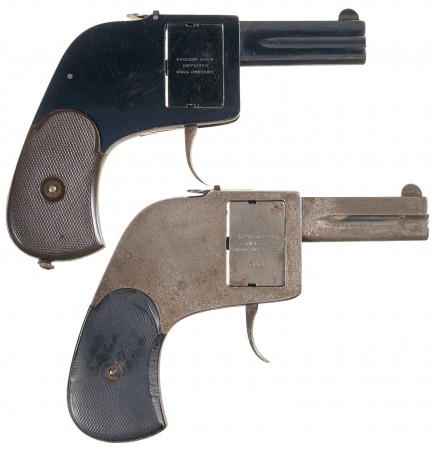
For the shooter who wants slightly more modern sort of Germany handgun, how about this lot of HK pieces (Lot 4866)? It includes a pair of less-common P7 pistols – an M10 in .40 S&W and a K3 in .32ACP – and an HK4 with the complete set of caliber conversions, so you can shoot .22LR, .25ACP, .32ACP, and .380 Auto. The P7 design is a pretty cool one, which I am looking forward to doing more coverage of, and the idea of one in .32ACP (and it can be converted to .38 as well) really appeals to me for some reason. The HK4 or a more conventional gun, but its factory set of caliber conversions is pretty neat.
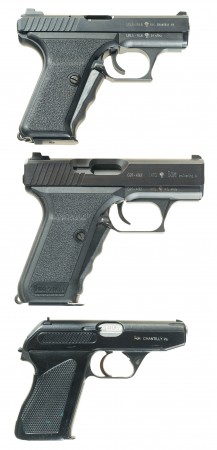
Okay, so you do like pistols, but you want something classy and old-world-elegant instead of modern black polymer? Well, I have a deal for you – Lot 2886! Some of the classiest American pistols ever made, whether you are a upstanding gentleman or a desperate outlaw. A set of a Colt 1903, and Remington 51 (the original fantastic one, not the failed modern reproduction), and a Baby Browning (made in Belgium). I think the Remington would be my choice to carry, just because it is more esoteric. I do adore the 1903 as well, though. In fact, the 1903 in this lot is in somewhat rough shape, but is from the very first year of production – that gun definitely deserves a loving home. I never really caught the Baby Browning bug myself, but they certainly have an important place as a classic vest-pocket carry pistol.
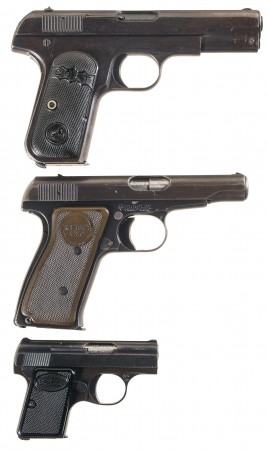
Moving away from handguns, there is a shotgun lot that I think is worth mentioning – Lot 2329. I’m normally not hugely interested in shotguns, but the two in this lot are special – they are two examples of the first pump-action shotgun design, invented by Christopher Spencer (of Spencer repeating rifle fame). Spencer wasn’t able to make them into much of a commercial success, and sold the parts, patents, and production line to Francis Bannerman in the late 1880s. Bannerman continued to make the guns into the early 1900s, with only a few changes. Well, the two guns in this lot both have some issues, but are pretty cool. The top one is an example made by Bannerman. It has the original huge 32 inch barrel, but the slide handle has been replaced (the original Bannerman ones were ribbed wood, and a bit fragile). The bottom gun appears to actually be a Spencer-manufactured example, which would be rather rare – although it has had its barrel cut down at some point (a very practical modification, really). I may kick myself later for not trying to get this Spencer one, but I do already have a Bannerman example in my collection. So here’s your chance to snag a cool piece of history for yourself…

Speaking of Christopher Spencer, how about getting a couple carbines for the .56 caliber Spencer cartridge (Lot 2110)? This lot has a Spencer saddle-ring carbine and a Triplett & Scott carbine. The Spencer is reasonably well known – the first repeating arm formally used by the US military. It has a tube magazine in the stock and was influential, although obsolete by the end of the Civil War. The Triplett & Scott is a much less common design, with only about 5000 made, and not delivered until after the end of the Civil War. It was also chambered for the Spencer cartridge, and also had a tube magazine in the end of the stock. Unlike the lever-action Spencer, though, it had a pivoting hinge between the barrel and receiver. It was loaded by rotating the barrel assembly 180 degrees around the axis of the barrel. At about 90 degrees rotation an automatic ejector would remove the fired case, and at full rotating the barrel would line up with the magazine and feed a new cartridge into the chamber. The barrel could then be rotated back up, locked in place, and fired.
Both of these carbines are in kinda rough condition – they have clearly seen a lot of use. Frankly, that’s how I like my guns – but your opinion may vary. The Spencer has an obviously repair to the right side of the butt, and the Triplett & Scott has the typical large crack along the magazine tube on the left side (the wood there was very thin to allow room for the magazine, and this is a common problem).
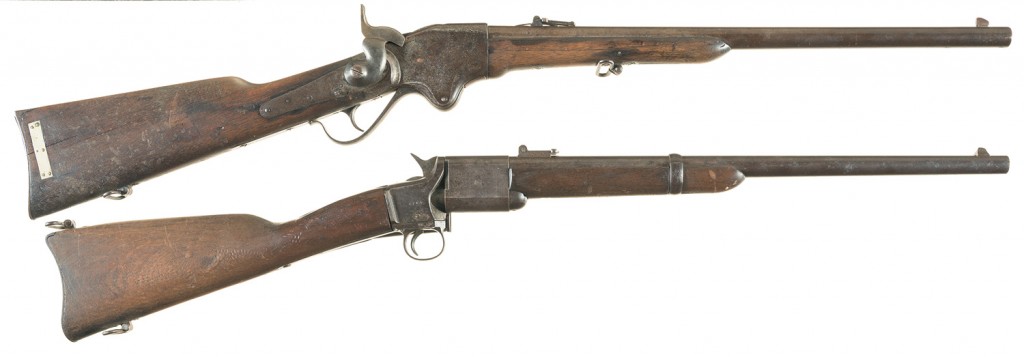
Not the carbines you’re looking for? How about a Rolling Block and an Evans (Lot 2137)? The Remington Rolling Block is a classic staple of the single-shot military rifle era – I believe this one is an Argentine military contract gun (it’s a bit tricky to tell without seeing the markings on the top). The Evans, on the other hand, was the highest-capacity repeater available at the time – its helical magazine would hold no fewer than 26 rounds of .44 Evans Long. I’ve commented on Evans carbines from previous RIA auctions, and they remain as cool as ever.
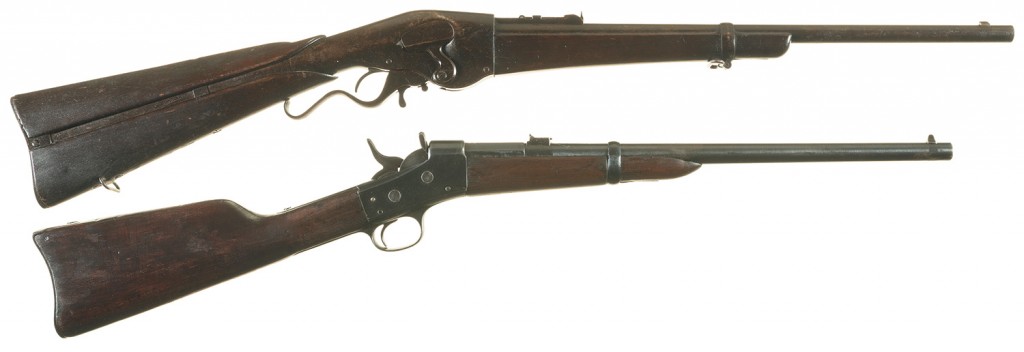
Lastly, I have a lot for the collector of Thai arms: Lot 2506. In addition to a decent Type 38 Arisaka (the catalog had it mislabeled as a Type 99), a Mk II Martini-Henry, and a rough Mexican Mauser, it includes a Type 46 Siamese Mauser, made under contract by Koishikawa Arsenal in Japan. What makes this one special is that it is still in its original 8x50R cartridge, as you can tell by looking at the unmodified rear sight. Most of these rifles were rechambered to the 8x52R spitzer cartridge by the Thai government in the 1920s. Not that 8×50 is any easier to find than 8×52 (it’s not the same as the French 8×50 Lebel), but the original configuration is a scarce find.
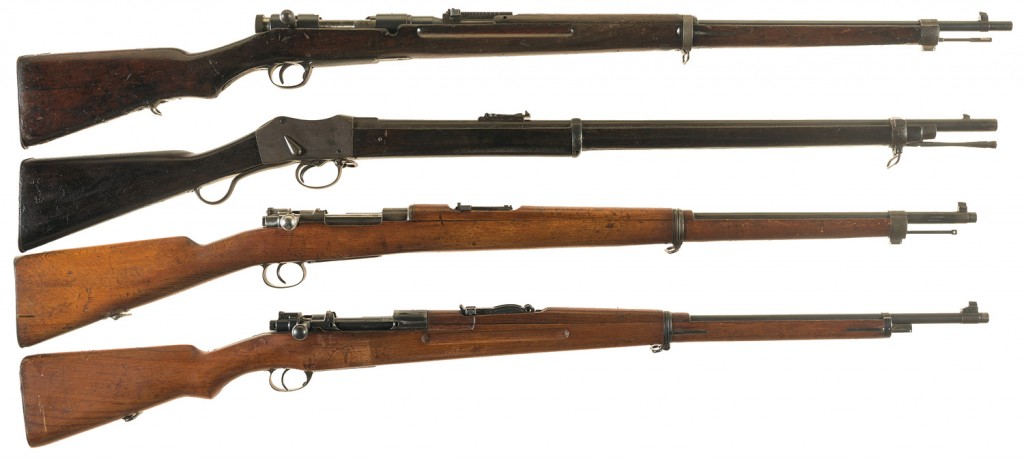
Of course, there are thousands of other lots available in the auction, and plenty of them are also very cool – but I’ll leave it to you to browse through the catalog and find them yourself! If I give away all the hidden treasures, how will I manage to get a good deal myself?

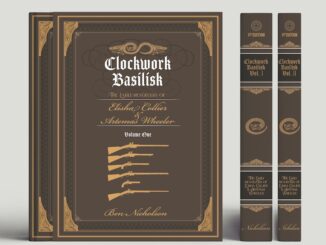
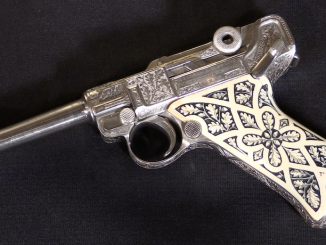

“Spencer-Bannerman shotguns”
Note that it is hammerless design. I always think that first pump-action is exposed-hammer like Winchester Model 97.
“Remington 51 (the original fantastic one, not the failed modern reproduction)”
Have you any link to reliable source covering the malfunction of this gun? I hope it would not do dark fame for Pedersen’s designs. This is great irony because as far as I know firearms designed by Pedersen work flawlessly.
Average Joe did a very good job reviewing the R51 on a recent Gun Nation podcast: http://www.gunnation.us/2014/05/5-7-2014show-no99-top-ten-i-think-not.html
If you prefer video content, Military Arms Channel has a good review: http://bearingarms.com/military-arms-channel-remington-r51-review/
In short, the problems are not Pedersen’s fault. To start with, the new R51 has an aluminum locking block slamming against a steel surface – need I say more?
Try this;
http://www.thetruthaboutguns.com/2014/02/foghorn/gun-review-remington-r51/
I’m disappointed as I was seriously considering this one.
Olympic’s repop of the old Whitney .22 didn’t work out too well, either. It seems like modern engineering is no substitute for the talents of the old-time “inventors”, doesn’t it?
cheers
eon
Modern engineering isn’t the problem, it’s the bean counters trying to cut costs as much as possible. I also think it’s; to a less of an extent the public’s constant desire for 460 magnum ballistics in a platform weighing in at 6oz.
I can easily imagine intolerable conditions with an engineer being told how to design by an accountant and someone from marketing.
What was the spoof gunzine article where the draft
” a diecast zinc copy of a Nambu, trigger pull too heavy for the spring balance, fired it from a machine rest with a very long rope, it burst like a hand grenade and at least 8 pieces of shrapnel shredded the target, I’m still shaking”
turned to;
“proven design combined with space age manufacturing and materials, and modern safe carry features. It can put eight holes in the black faster than any gun we’ve seen. We think you’ll be surprised by its performance”
after the maker paid for a double page advert?
If they have pistol which could be easily (read: cheaply) manufactured the Remington Model 51 is very poor design, because is don’t match current era of metal-stamping and metal-casting firearms but is machined like vast majority of early 20 century automatic pistols.
—
It is looks like the Remington start producing their new R51 too fast delivering to users rather prototype (semi-prototype?) than working pistol. What can cause the fact of premature model production – Remington seeks some contract with organization-user?
Possibly, but more likely Remington saw the explosive growth of demand for compact defensive pistols due to concealed-carry laws, and unlike Colt didn’t want to end up missing out on the market.
Colt’s present reduced state is mainly the result of thirty years of amazingly wrongheaded marketingdecisions by management, as opposed to engineering failures. Although they’ve had some of those too, notably the Colt Double Eagle. I still believe the Colt P2000 got a bad rap and was marketed badly, as opposed to purely mechanical problems, which it seemed to be remarkably free of.
Also, don’t forget that Ruger’s first service-type self-loader, the P90, went through a long period of teething troubles before it finally reached full operational capability and reliability as the P94 series.
Even in firearms, beta testing is best done first.
cheers
eon
I am far from being an expert on semi-auto pistol actions, but as far as I can see, there is nothing fundamental in the Pedersen “hesitation lock”, which would require a large number of machined parts. Both simple blowback and Browning type tilting barrel designs were originally implemented on pistols which had a large number of machined parts, but both were transferred to modern manufacturing methods successfully.
I agree that it might have been better if Remington had started from the less demanding .380 ACP and moved up to 9x19mm later, but on the other hand I can see why they didn’t, if they wanted the pistol to sell in the US concealed carry market. For a single stack .380 ACP pistol the R51 would be somewhat large by modern standards, although logically, if the target market really is women and older people with limited hand strength, .380 ACP should be plenty powerful. And while there are many compact and sub-compact pistols available in .380 ACP, none of them can claim to be very friendly for people with limited strength.
Re: Lot #2506
That’s a Mexican M1910, not Spanish, which makes two uncommon Mausers in that lot. Also, the first rifle is a Type-38 Arisaka, rather than a Type-99.
Good catch – I’ve corrected my commentary. Thanks!
And I’ve submitted it for a correction. Thank you.
A just so I can sleep tonight question. On both Spencer-Bannerman shotguns there is a concave lever within the triggerguard forward of the trigger itself. What the hail is that? A safety? Slide release? Takedown lever? Something else? Thanks in advance for your answer.
When pushed forward, it cocks the striker. It allows you to get a second strike on a dud cartridge without cycling the action.
Nice feature, I’ve passed up a few Spencer shotguns before but I might try for this one.
Both P7 pistols are specific examples for the kind which working in “Mass Lock” principle in fact, since M10 being backed up by a conventional gas brake and M3 backed up by a hydrolic buffer.
For your information, what you call “mass lock” (“Masseverschluss” in German) is a called “blowback” in English. The type used by the P7 (except the K3) is usually called “gas-delayed blowback” (whereas the P7K3 is “simple” or “straight blowback”).
Thanks for the education. However, past HK experiments showed that gas brake(or Gas Delay as you preferred) capabilities could not go beyond the power of 9mm Para. Round since larger caliber pistols needed extra mass to keep the chamber closed at instant of firing. Interestingly, .380″ caliber M3 also needed a hydrolic buffer to keep the frame unstressed. These cases may also be translated, both pistols based on simple blowback working principle, but backed up by different concepts to keep the frame unstressed. Therefore, the term “Mass Lock” suits better to describe the construction rather than “Simple Blowback”. Your possible added education about the cause of HK’s way to follow those preferences would be much appreciated.
Hmm, P7 as a “cool” pistol… As far as I remember, it was actually anything but cool after 50 shots. Hot (literally) enough to give me a blister on my trigger finger. Don’t even think about shooting one without a glove.
The Evans is way up on my “must have” list, but I’d love to give them all a home. My wife says I’m not a collector but a hoarder. She’s probably right, so I asked her if she’d rather I spent my money on hookers.
Personally, I aspire to keep them away from them that would hoard them 😉
Some interesting points about P7 pistols;
– Trigger/striker connections were fully borrowed from Mauser 1910/14 pistols with exception that, pivoting sear lever being located over a rotatably mounted lever on the receiver which drivable to be cocked position by another pivoting draft lever located in the front of handle.
– Most notable and valuable feature was their very low barrel axis which carried over by taking the sear lever and striker connections to the side and by means, approximately 2 centimeters of height in depth was saved to lower the slide over the receiver as comparing those using mentioned connections in a common vertical plane.
– Passive striker block permitted only strokes to reach and detonate the blows coming from self powered firing pin. Those reaching beyond that distance was stopped by its body and therefore, dry firing these pistols might harm or even break the passive striker block.
– Most of moving parts were constructed by press cut and forming applications and some investment cast parts like “Striker Holder” might be subject to breakage through inertia.
– The passive striker block was also subject to pop out of its location since retaining overthere only by compression of its torsion spring. In case of its dislodge,
the pistol happened fully unoperational turning out to a steel paper weight.
No need to mention about their common issues like heating or needing perfect holds free from stress and etc.